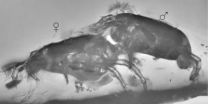(Press-News.org) PROVIDENCE, R.I. [Brown University] — Excessive weight gain isn't healthy at any stage of life, but during pregnancy it can do lasting harm to the mother and baby alike. Now researchers at Brown University and The Miriam Hospital are encouraged by a new study describing an intervention that helped pregnant women control their weight.
"This study suggests that a lifestyle intervention can help women manage their weight during pregnancy, prevent health problems during pregnancy, and reduce weight retention after having a baby," said study lead author Suzanne Phelan, adjunct assistant professor of psychiatry and human behavior at Brown and an associate professor of kinesiology at California Polytechnic State University.
Women whose weight was in a normal range before pregnancy were more likely to stay at a healthy weight if they received the intervention during pregnancy compared to women who received standard care, according to the randomized controlled study of 400 women, published online this month in the American Journal of Clinical Nutrition. The intervention also increased the chance of returning to their pre-pregnancy weight six months after delivery. The intervention did not help women who were obese or overweight before becoming pregnant to stay within the recommended weight gain goals during pregnancy, but it did help them return to their pre-pregnancy weight after delivery.
"I think it's an important study," said co-author Rena Wing, professor of psychiatry and human behavior at the Warren Alpert Medical School of Brown University and The Miriam Hospital. "The goal during pregnancy is to help women gain within the recommended amounts. Our study succeeded for normal weight women, but we need to develop a more effective approach for women who are overweight or obese."
The Institute of Medicine's latest guidelines recommend, for example, that normal-weight women gain between 25 and 35 pounds and that obese women gain 11 to 20 pounds. Otherwise, the health consequences for expectant mothers and their babies could be serious, said study co-author Maureen Phipps, interim chair of obstetrics and gynecology at the Alpert Medical School and Women & Infants Hospital.
"Excess weight gain during pregnancy increases the risk for developing gestational diabetes and problems with high blood pressure during pregnancy," Phipps said. "Obesity is associated with an increased risk for cesarean delivery, fetal growth problems, and premature birth. In addition to adding to the difficulty of losing weight post partum, excess weight gain during pregnancy can have long-term health consequences for both the mother and the infant."
Fit for delivery
The team devised an intervention that they hoped would be effective, but also "low-intensity" so that clinicians and patients could stick with it. Patients randomly selected to receive the intervention went to an initial, face-to-face meeting with an interventionist who coached them on topics such as what constitutes healthy pregnancy weight gain, the need for physical activity such as walking, calorie goals, reducing fat intake and daily self-monitoring. Women received scales, pedometers and forms for recording what they ate.
From there, the intervention proceeded exclusively via the mail and by phone with weekly reminder postcards and three calls from a dietitian to offer encouragement. After each visit to their doctor's office, the women would also receive graphs showing them their weight gain compared to what would be ideal based on health guidelines. Women who were gaining too much or too little received additional follow-up coaching calls from the study dietitian.
Among normal-weight women who received the intervention, 40.2 percent gained more than the IOM recommendations, but among comparable women who did not receive the intervention, 52.1 percent gained too much. Six months after delivery, 35.6 percent of women who received the intervention were at or below their pre-pregnancy weight, compared to only 20.7 percent who received only standard care.
Obese or overweight women struggled more to control their weight during pregnancy. Exactly two thirds — 66.7 percent — of obese or overweight women who received the intervention and 61.1 percent of those who did not gained more than the 1990 IOM recommendation (the study took place before the newest guidelines for obese women). That difference between those who received the intervention and those who did not, Wing said, was not statistically significant. But after birth, obese or overweight women did gain a statistically significant benefit from the intervention: 25.6 percent of those in the intervention group returned to their pre-pregnancy weight or below, compared to only 16.7 percent of women who received standard care.
"What might have happened is that obese and overweight women learned skills during the pregnancy that they had difficulty implementing at that time," Wing said. "After the pregnancy they were able to implement these skills more effectively and so got back to their pre-pregnancy weights."
Normal-weight women may have also benefitted medically from the intervention. Women in the intervention group were nearly four times less likely to experience high blood pressure and three times less likely to have preeclampsia, but Wing cautioned that the absolute numbers of women showing symptoms in either group — fewer than a dozen — was very small, making the results difficult to interpret.
Future directions
Wing's research group will now look at how the intervention might be tweaked to be more helpful for obese women while they are still pregnant.
Phelan, meanwhile, said she is interested in getting the intervention into the hands of doctors.
"One of the next steps is to implement the intervention as part of standard care," she said. "We designed the intervention with dissemination in mind, and so another study will test its effects as part of clinical practice."
###
In addition to Wing, Phelan and Phipps, other authors on the study include Barbara Abrams, Francine Darroch, Andrew Schaffner. The National Institutes of Health funded the study.
Intervention helps women manage weight during and after pregnancy
2011-03-01
ELSE PRESS RELEASES FROM THIS DATE:
Gay rights movement born in 19th century Germany, scholar says
2011-03-01
Same-sex erotic relationships are as old as humanity, but our modern understanding of what it means to be homosexual—and the earliest gay rights movement—started in nineteenth-century Germany, according to an article by historian Robert Beachy from Goucher College.
The article, "The German Invention of Homosexuality," is published in a recent issue of The Journal of Modern History. Beachy's book on the subject, Gay Berlin: Birthplace of a Modern Identity (Knopf), is due out next year.
According to Beachy, modern conceptions of homosexuality began, ironically, with an ...
New peptide could be effective treatment for triple negative breast cancer
2011-03-01
A new peptide developed by researchers in Temple University's College of Science and Technology has demonstrated efficacy against triple negative breast cancer.
The leptin receptor antagonist peptide, developed by researchers Laszlo Otvos and Eva Surmacz, could become an attractive option for triple negative breast cancer treatment, especially in the obese patient population. The researchers published their findings online in the European Journal of Cancer.
According to the researchers, triple-negative breast cancers—which represent 10 percent of all mammary ...
Development team achieves 1 terabit per second data rate on a single integrated photonic chip
2011-03-01
WASHINGTON, Feb. 28—With worldwide Internet data traffic increasing by 50 percent each year, telecommunications companies that handle this digital torrent must be able to economically expand the capacities of their networks while also adapting to new, more-efficient data-handling technologies. Over the last decade, a development team at Infinera Corp. in Sunnyvale, Calif. has pioneered the design and manufacture of photonic integrated circuits (PICs) aimed at meeting that need. This technology has enabled the team to achieve a record one trillion bits per second (1 Terabit/s) ...
Researchers develop curious snapshot of powerful retinal pigment and its partners
2011-03-01
BETHESDA, Md., Feb. 28, 2011 – Science fiction novelist and scholar Issac Asimov once said, "The most exciting phrase to hear in science, the one that heralds new discoveries, is not 'Eureka!' but 'That's funny.' " This recently rang true for an international team of researchers when they observed something they did not expect.
In a Journal of Biological Chemistry "Paper of the Week," the Berlin-based team reports that it has uncovered surprising new details about a key protein-protein interaction in the retina that contributes to the exquisite sensitivity of vision. ...
Full bladder, better decisions? Controlling your bladder decreases impulsive choices
2011-03-01
What should you do when you really, REALLY have to "go"? Make important life decisions, maybe. Controlling your bladder makes you better at controlling yourself when making decisions about your future, too, according to a study to be published in Psychological Science, a journal of the Association for Psychological Science.
Sexual excitement, hunger, thirst—psychological scientists have found that activation of just one of these bodily desires can actually make people want other, seemingly unrelated, rewards more. Take, for example, a man who finds himself searching ...
MIT-- parts of brain can switch functions
2011-03-01
Cambridge, MASS- When your brain encounters sensory stimuli, such as the scent of your morning coffee or the sound of a honking car, that input gets shuttled to the appropriate brain region for analysis. The coffee aroma goes to the olfactory cortex, while sounds are processed in the auditory cortex.
That division of labor suggests that the brain's structure follows a predetermined, genetic blueprint. However, evidence is mounting that brain regions can take over functions they were not genetically destined to perform. In a landmark 1996 study of people blinded early ...
Gut bacteria can control organ functions
2011-03-01
Bacteria in the human gut may not just be helping digest food but also could be exerting some level of control over the metabolic functions of other organs, like the liver, according to research published this week in the online journal mBio®. These findings offer new understanding of the symbiotic relationship between humans and their gut microbes and how changes to the microbiota can impact overall health.
"The gut microbiota enhances the host's metabolic capacity for processing nutrients and drugs and modulates the activities of multiple pathways in a variety of organ ...
Mating mites trapped in amber reveal sex role reversal
2011-03-01
ANN ARBOR, Mich.---In the mating game, some female mites are mightier than their mates, new research at the University of Michigan and the Russian Academy of Sciences suggests. The evidence comes, in part, from 40 million-year-old mating mites preserved in Baltic amber.
In a paper published March 1 in the Biological Journal of the Linnean Society, researchers Pavel Klimov and Ekaterina Sidorchuk describe an extinct mite species in which the traditional sex roles were reversed.
"In this species, it is the female who has partial or complete control of mating," said Klimov, ...
Dry lake reveals evidence of southwestern 'megadroughts'
2011-03-01
LOS ALAMOS, New Mexico, February 28, 2011—There's an old saying that if you don't like the weather in New Mexico, wait five minutes. Maybe it should be amended to 10,000 years, according to new research.
In a letter published recently in the journal Nature, Los Alamos National Laboratory researchers and an international team of scientists report that the Southwest region of the United States undergoes "megadroughts"—warmer, more arid periods lasting hundreds of years or longer. More significantly, a portion of the research indicates that an ancient period of warming may ...
Silk moth's antenna inspires new nanotech tool with applications in Alzheimer's research
2011-03-01
ANN ARBOR, Mich.---By mimicking the structure of the silk moth's antenna, University of Michigan researchers led the development of a better nanopore---a tiny tunnel-shaped tool that could advance understanding of a class of neurodegenerative diseases that includes Alzheimer's.
A paper on the work is newly published online in Nature Nanotechnology. This project is headed by Michael Mayer, an associate professor in the U-M departments of Biomedical Engineering and Chemical Engineering. Also collaborating are Jerry Yang, an associate professor at the University of California, ...


